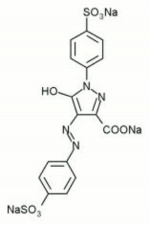Tartrazine
Revision as of 13:12, 27 April 2013 by (username removed)
Description
A yellow monoazo dye discovered in 1884 by H. Ziegler. Tartrazine is used to color food, drugs, cosmetics, wool, fiber nylon, jute, leather, silk, paper, and acid dyeable fiber acrylic fibers. Because many people experience allergic reactions, the use of tartrazine as a food colorant is banned in Norway and Austria. It is still used in many other countries, including the U.S., in colas, candies, soups, jelly, and many other food products.
Synonyms and Related Terms
CI 19140; Acid Yellow 23; Food Yellow 4; FD&C Yellow 5; Solvent Yellow 57; Lampronol Yellow J; Pigment Yellow 100 (aluminum lake); Tartrazin (Deut.)
| Composition | C16H9N4O9S2Na3 |
|---|---|
| CAS | 1934-21-0 |
| Melting Point | 215 (dec) |
| Density | 1.93 |
| Molecular Weight | mol. wt. = 534.35 |
Hazards and Safety
Hygroscopic. May cause allergic skin reactions, migraines, or blurred vision.
Fisher Scientific: MSDS
Authority
- Colour Index International online at www.colour-index.org Comment: discover, CI, CAS, uses
- Wikipedia, the free encyclopedia, at http://www.wikipedia.com Comment: http://en.wikipedia.org/wiki/Tartrazine (Accessed Sept. 28, 2005) - allergic reactions, contained in Mountain Dew

